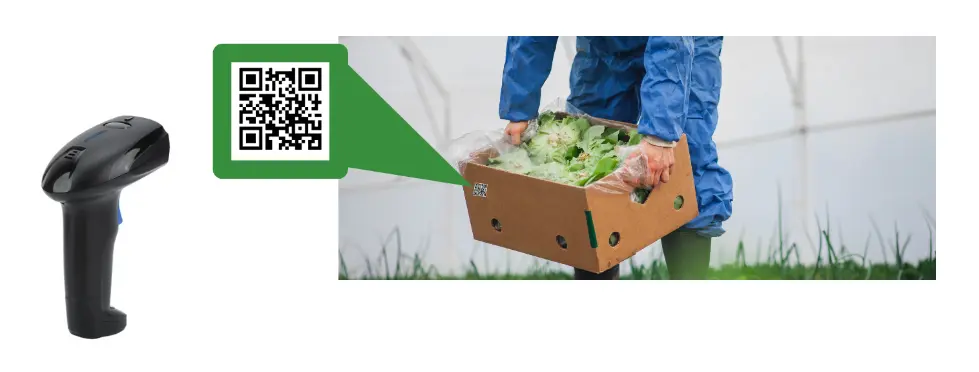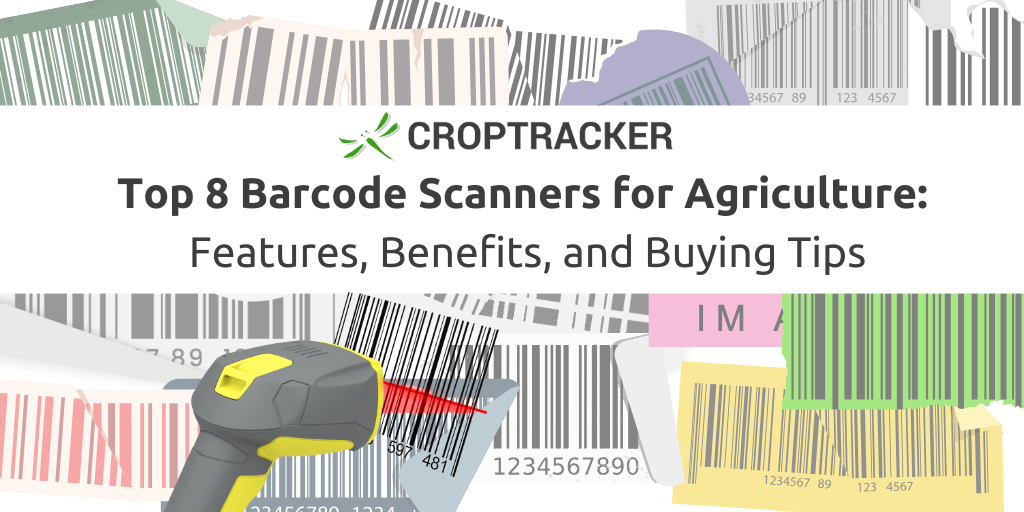If you’re in the agriculture industry, you know how crucial it is to keep operations efficient, organized, and precise. Increased traceability demands, like those imposed by FSMA204, mean more information about products needs to be recorded at every step in the supply chain. Saving valuable time at each of these Critical Tracking Events is vital to maintain operational efficiency. In order to quickly encode and record inventory information through these steps, barcode scanners have become an essential tool for farms and agribusinesses of all sizes. Code readers help streamline inventory management, traceability, and product tracking across various stages of production and distribution. But with so many models and features on the market, finding the right scanner for your operation can feel overwhelming.
In this guide, we define some essential terms you may encounter while shopping to help you make an informed decision. We also break down the key features to look for in a barcode scanner for agricultural use—like rugged durability, scanning range, and connectivity options. Finally, we have gathered a list of 8 best-selling barcode scanners that offer excellent performance for agricultural applications. Whether you're managing a large farm or a small agribusiness, this guide will provide everything you need to choose the right barcode scanner to support your operation’s needs.
Definitions for Understanding Barcode Scanner Features
1D code: Refers to a traditionally formatted barcode with vertical lines. It can encode a number and letter sequence. See an example 1D Croptracker tag below.
Example Croptracker Harvest tag with 1D code
2D code: Sometimes called a QR code, a 2D code is a square formatted code made with rectangles, dots, hexagons or other shapes. Both the positive and negative space are read and it can generally contain more complex information than a 1D code. It is also often more readable at a distance making it useful in agricultural settings. See an example of a 2D Croptracker tag below.
Example Croptracker Packing pallet tag with 2D code
Ingress Protection Rating (IP): Refers to the durability score of a technology, taking into account its resistance to moisture, dust and dirt and impacts. For a tool to be rugged enough for use in Agricultural or Industrial settings, it should have an IP score of at least 65.
Focal Point: Refers to the optimal distance from which a barcode can be read by the scanner. It is sometimes referred to as the Range. Some scanners have programmable ranges so they can get set to read a code at a regular distance.
Field of View: Is the width and height of the area the scanner can capture or "see" at a given distance. A larger field of view allows the scanner to capture more information and scan wider or larger barcodes in a single pass. In agricultural applications, where barcodes might vary in size or shape, having a flexible field of view can make scanning faster and more effective.
Optical Resolution: Refers to the scanner's ability to capture fine details in a barcode. Higher optical resolution means the scanner can accurately read small or densely packed barcodes. In agriculture, where conditions may cause barcodes to get damaged, dirty, or faded, having a barcode scanner with high optical resolution ensures reliable scanning even in challenging conditions.
Keyboard Wedge Mode: A barcode scanner feature that allows scanned barcode data to be directly input into any program or software as if it were typed from a keyboard. This mode eliminates the need for additional software integration, making it simple for users to input data directly into spreadsheets, inventory systems, or other software commonly used in agricultural operations.

Key Features for Barcode Scanners in Agriculture
Durability:
Durability is one of the most important features needed in a barcode scanner for agriculture. Whether it is used from a forklift in the warehouse or out in the field scanning cases onto trucks for delivery, a rugged scanner should be able to withstand moisture, temperature fluctuations and dirt. It should also be able to survive being dropped more than a few times. Scanning labels off bins going in and out of cold storage or out in a hot and humid field should not cause issues with the scanner. Look for scanners with a listed IP score of at least 65. Some spec sheets will list whether it is high or low-temperature rated and moisture resistant and how far it can fall without damage separately as opposed to an IP rating.
Portable and long-lasting:
A good scanner in the field, at shipping stations or in a warehouse needs to be battery-powered in order to allow for movement and to avoid safety issues with wires. With a regular shift being 8-10 hours and overtime potential in peak harvest times, an ag worker needs to be able to use a scanner for a long time on a single charge. Battery-powered scanners that have a power-saving mode and long run time will be key to avoiding work stoppages while scanners recharge or are exchanged for charged ones.
High-resolution and multi-format scanning:
A good barcode scanner should not be limited to one style of code reading. Many agricultural storage, packing and sales facilities will receive inventory from multiple locations, often with their own tag and barcode formats. Look for scanners that can handle a wide variety of 1D and 2D barcode formats. Due to the realities of ag work and cold or long-term storage of some products, a good barcode scanner should also have a high enough resolution to still be able to read worn or damaged tags.
Long Rage Scanning:
In order to ensure worker safety and efficiency, many operations will require a tag reader that can read a label from a forklift or a receiving bay. Having a barcode reader be able to reach more than a couple of feet may be essential, especially if labels are up in a stack of bins or a tall pallet. Being able to eliminate the need for step ladders or unnecessary de-stacking saves valuable time.
Wireless Connection and Data Management Integration:
Agriculture and warehouse scanners will generally be able to connect to your devices wirelessly to take in data. We recommend ones that can connect via Bluetooth as well as or are opposed to WiFi connections so the connection is not lost when entering areas with potentially little or no WiFi signal, like a cold storage room. It is also important for the data integration to your data or farm management software to be easy to set up. To avoid complicated programming and configuration, we recommend looking for scanners with a ‘Keyboard Wedge’ option that allows for easy data field filling in from bar codes. This is a fairly common feature in most scanners.
Ease of Use:
Due to the often loud environment where barcode scanners are being used, like a pack house or receiving bay, it is important for the feedback when a tag is recognized to be quite loud or be a different visual or tactile indicator, like lights or vibration. It should also be easy to use the tool. Having many buttons and complicated written instructions will make it a hard tool to use for workers who may not read the language of the device.
GPS Tracking and Networking:
Some of the more sophisticated and expensive scanners have GPS tracking and tethering options. To ensure devices stay in the workstations they are meant to be used in, some devices can be programmed to only work within specific areas. Additionally, it may be beneficial to have scanners that can be networked together so that information gathered on one device can be synced with other devices

8 Top Barcode Scanners for Agriculture
Below is a list of barcode scanners favored by the ag industry. Please note approximate prices are listed in USD. We have grouped them into three categories, wearable scanners, handheld scanners and mounted scanners. Wearable scanners have the advantage of allowing for hands-free use and less likelihood of misplacing the scanner. Rugged handhelds are the most adaptable and can be easily passed to others and maneuvered to reach tags. Mounted barcode scanners have the advantage of being hands-free and very useful for receiving points or storage doors as they can be programmed to read specific tags at target distances to ensure accurate data collection.
Wearable:
ProGlove Mark 3 Wearable Barcode Scanner
~ Price: $1000.00
Feature Highlights: 12,000 scans on a single charge with only a 2-hour charging time. Lightweight and features a handy laser aiming for quick code alignment.
Zebra RS6100 Series Bluetooth Wearable Scanner
~ Price: $1500.00
Feature Highlights: Multiple wearable options including ring, glove and lanyard. Programmable feedback to confirm scanning. Easily swappable batteries and a charging port that can charge up to 40 batteries at one time.
Handheld:
Zebra DS3600 Series
~ Price: $900.00
Feature Highlights: Very durable and weather resistant for outdoor receiving/shipping bay scanning. Long scanning range with high resolution.
Honeywell Granit XP 1991iSR Barcode Scanner
~ Price: $850.00
Feature Highlights: Can survive a 10ft drop and operate in extreme temperatures and high humidity conditions. Has high-resolution scanning capabilities to handle damaged tags.
Brady V4500 Wireless Bluetooth Programmable Barcode Scanner
~ Price: $1000.00
Feature Highlights: Super durable with 250lb crush resistance, 6ft drop rating and military-grade shock resistance.
Omron V450 Rugged Handheld Barcode Reader
~ Price: 2000.00
Feature Highlights: High durability rating on IP65 including the charging cradle resulting in very long-term use. 50,000 scans between charges and moisture and chemical resistance.
Mounted:
Zebra FS Fixed Industrial Scanner Series
~ Price: $3500.00
Feature Highlights: The series includes many options to fit specific use cases and setups. Can scan at very high speeds to support scanning products moving over a line.
Honeywell Fixed Mount Scanners HF Series
~ Price: $1000.00
Feature Highlights: Long-range scanning capabilities for door mounts. Easy and fast setup with add-ons to support advanced capabilities.
In the agriculture industry, barcode scanners have become indispensable tools for streamlining inventory management, enhancing traceability, and improving operational efficiency. With a variety of rugged, high-performance scanners available, selecting the right one can make a big difference in productivity. From wearable and handheld scanners to mounted options, each type offers distinct advantages tailored to specific agricultural needs. By focusing on key features like durability, connectivity, scanning range, and ease of use, you can find a scanner that aligns perfectly with your operation's demands.
Whether you’re scanning produce in the field, tracking shipments in the warehouse, or monitoring items at receiving points, the right barcode scanner will help you capture essential data accurately into your management software, saving you time and ensuring product traceability at every step.


